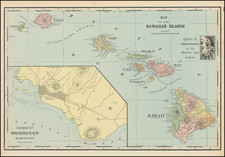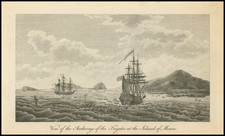A Complete Set of Paul Emmert's Exceptional Views of Honolulu.
Six hand-colored lithographed views of Honolulu, comprising a complete set of the finest views of Honolulu published in the 19th century.
Emmert's views of Honolulu are of tremendous historical importance, being the most complete visual record of the major buildings, residences, consulates and other structures in the years immediately following Honolulu's becoming King Kamehameha III's capital of the Hawaiian Kingdom. Emmert's views are among the most important early visual artifacts of Hawaiian history. The view was still hanging on the wall beneath the front window of the Bishop's Museum Picture Gallery in 1915.
The set consists of one view of Honolulu looking into the city from the harbor ("No. 1"), and five views (together comprising one long panorama) taken from on top of the tower of the Catholic Church. Each view is surrounded by a host of vignettes showing buildings and smaller scenes around Honolulu. Taken altogether they represent an unparalleled visual record of life and architecture in Honolulu in the early 1850s.
All of the buildings in Emmert's vignettes are carefully labeled; sheet No. 1 shows major public buildings including the Palace of King Kamehameha III, the interior of the for the fort, the courthouse, Market House, Charity School, Stone Church, the Armory, and the steamer Akamai; sheet No. 2 primarily shows diplomatic buildings, including the house of the Peruvian Consul, U.S. Consul, U.S. Commissioner, Bremen Consul, Swedish Consul, Danish Consul, French Consul, etc.; the other sheets show businesses and larger private homes.
History of Production
The views are based on original drawings undertaken by Paul Emmert during 1853 and early 1854 (see the Emmert biography below for more details).
In May 1854, the Honolulu newspaper Polynesian published a preliminary review of Emmert's views:
Views in Honolulu,
We have had the pleasure of examining a series of drawings by Mr. Paul Emmert, and embracing all the principal buildings, classified, and arranged as a border around the central views.
Mr. Emmert, we understand, intends having all these lithographed, in a superior manner, and if so we can recommend them as accurate representations of the city and buildings of Honolulu. He soon leaves for San Francisco, for this purpose intending to return in a few months with copies of his views for sale, for which we anticipate a large demand and ready sale.
When Emmert returned from San Francisco, in October 1854, Polynesian published a follow up:
Emmert's Views of Honolulu.
We have before alluded to a series of representations of Honolulu, embracing its principal public and private buildings, by Mr. Paul Emmert. The whole series, six in number, is now completed, and have been received in Honolulu, but where they are for sale, we have not been informed.
These views are executed in a fine style of art, and reflect much credit on Mr. E. who took the drawings, and who has brought them out in San Francisco at much cost and labor.
The public will doubtless be informed when they are ready for sale, and where they are to be procured, and we hope a liberal community will appreciate Mr. E.'s talent and labor by an extensive purchase of these beautiful views.
The Honolulu Friend noted that the set of six lithographs comprised a panorama two feet wide and twelve feel long and took Emmert and two assistants three months to complete at a cost of over $4,000. The views were offered for sale at $3.00 each or a set of six for $15.00, and Emmert opened a lithography and wood engraving studio over Vincent Grenier's store on Nuuanu Street.
Rarity
The complete set of views is extremely rare, with no record of the set appearing at auction or in a dealer catalog and especially not in full period color. A recent biographical sketch on Emmert noted 3 complete sets.
- Bancroft Library (UC Berkeley)
- Astor, Lennox and Tilden Foundation (New York Public Library)
- Amon Carter Museum (Fort Worth, Texas)
We note a fourth set at Yale in the Beinecke Library (A gift from the Paul Mellon Collection). Reps also noted a complete set at the Hawaii Historical Society and the Bishop's Museum Library (Honolulu).
OCLC locates single examples of No. 3 View of Honolulu, From The Catholic Church at the University of Connecticut. We note two uncolored examples offered by William Reese (No. 3 and No. 5) and a single example of No. 5 offered for sale at auction in 2009.
The views are also known in a tinted lithograph edition (printed in two colors, black and beige). We speculate that this set was issued before the second stone was completed, and that hand-coloring was added in lieu of tinting.
Bishop Museum Handbook, Part 1, p. 94 (1915)
Paul Emmert was a Swiss-born moving-picture panorama and scenic painter and lithographer.
By 1845, Emmert had migrated to New York, whereby 1845 he had established himself as a painter in the Bowery.
Emmert in California
In 1849, Emmert sailed to California, where he created the artwork for Emmert & Penfield's Original Panorama of the Gold Mines, the first moving panorama of the Gold Regions of California, which debuted at Gothic Hall in Brooklyn in March, 1850. The first reel traced the route from California to the Isthmus of Panama. The second showed the route from Acapulco to Colima, Mexico. The third reel shows the Entrance to San Francisco through the Golden Gate, the City of San Francisco, Happy Valley, Benicia, the Sacramento River and city. The final reel covered Sutter's Fort, Mormon Island, Mississippi City, Hang Town, Culloma, or Sutter's Mlll, Spanish Bar, Big Bar, Volcanic Bar, Rector's Bar, and more. After a year in New York, the panorama was exhibited in St. Louis in 1851.
After returning to San Francisco in September 1850, Emmert created a new panorama, which debuted in Sacramento at the Pacific Theater in April 1852, which would tour a number of other cities in California. Said to be nearly a mile in length, Emmert 's moving canvas featured representative scenic views and images of the mining districts, as well as a dramatic depiction of the city of Sacramento inundated by the muddy waters of one of the terrible floods that periodically swept the Central Valley.
Emmert in Honolulu
In February 1853, Emmert sailed for Honolulu. He immediately set out to compile a series of sketches, which would become his famed series of six lithographs of Honolulu, which would be published in San Francisco by Britton & Rey in 1854. The numbered set of views consisted of five lithographs entitled View of Honolulu from the Catholic Church and a Panoramic View of the City of Honolulu, Oahu. George Henry Burgess was responsible for much of the lithography in San Francisco, although his name appears on only one of the views.
In November 1853, Emmert published notice, along with Joe T. Downey, of his purchase of a theater business called "Foley's Varieties". Shortly thereafter the business must have gone very badly sideways; the Polynesian records that, in March of 1854, the Supreme Court of Hawaii had ruled against Downey and Emmert and found that they owed Asher B. Bates over six thousand dollars and that their assets were to be liquidated to satisfy the ruling. In May 1854, Emmert published his intention to leave Hawaii in the Polynesian.
In San Francisco, Emmert quickly set about having his drawings turned into views by Britton and Rey, and within months he was headed back to Hawaii.
Upon returning to Honolulu, Emmert set out to sell his views; The Honolulu Friend noted that the set of six lithographs comprised a panorama two feet wide and twelve feel long and took Emmert and two assistants three months to complete at a cost of over $4,000. The views were offered for sale at $3.00 each or a set of six for $15.00, and Emmert opened a lithography and wood engraving studio over Vincent Grenier's store on Nuuanu Street.
Emmert was involved in several other noteworthy projects, including designing the decorations for King Kamehameha IV's wedding in 1856. He made a trip to California as an artist for C.A. Shelton in 1858, before moving to the Kona Coast of the Big Island in 1859 to establish sugar cane plantation. He operated the plantation until 1864, before returning to Honolulu, where he took on assignments for the famous early photographer, Henry M. Chase.











![[Early Hand Drawn Map of the Hawaiian Islands]](https://storage.googleapis.com/raremaps/img/small/62429.jpg)

![(Maui). Harbours and Anchorages in the Hawaiian or Sandwich Islands. [Maalaea Bay and Kahului Harbor and Approaches]](https://storage.googleapis.com/raremaps/img/small/69674.jpg)
![[The Big Island] Hawaii Hawaiian Islands . . . / The Island of Hawaii](https://storage.googleapis.com/raremaps/img/small/83460.jpg)

